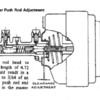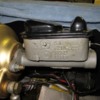Team Hi sorry an other of the mysteries (at least I did discover... ). I cannot get PRESSURE on the brake system ....
Starting point:
1) all new tubes, fully empty break system
2) NO Brake pressure balancer (front vs back)
3) Adapter/Booster applied (figure))
4) all O rings within the main cylinder look good to me (figure)
5) Main cylinder is NOT original I know, it supposed to have worked (I never tried it)
Situation:
a) the movement of the brake pedal I have adjusted to app 40 mm/1.6inch , so the push rod coming out of the Vacuum container can go FAR into the Break main cylinder.
b) The over stand of the push rod coming out of the Vacuum container has an over stand of app 8mm/0.3 inch at no action, hence the main cylinder hast already some push in at ZERO Brake pedal move, app 5mm/0.2 inch
b) the brake pike system got flushed via a vacuum pump
c) I cannot build up any pressure by pushing the brake pedal, neither by LONG movements nor by short movements.
Help..I am stuck and I missed today my date for the MOT/TÜV...a mess...(in nice words..)
Matthias
Attachments
Original Post



